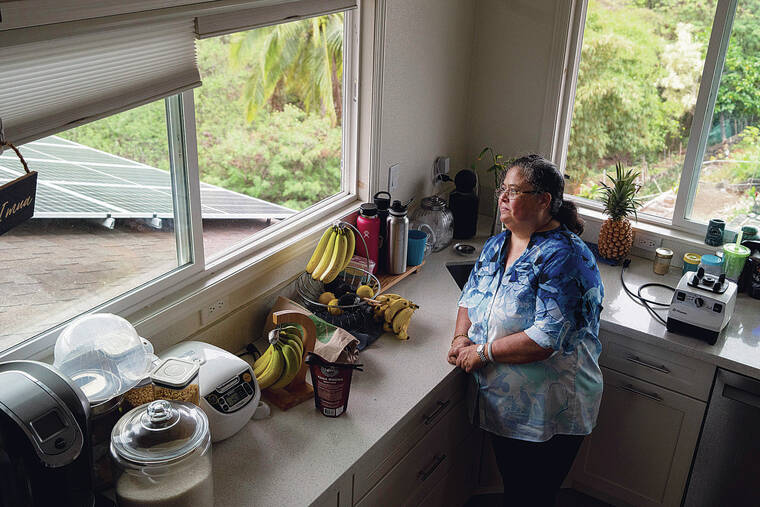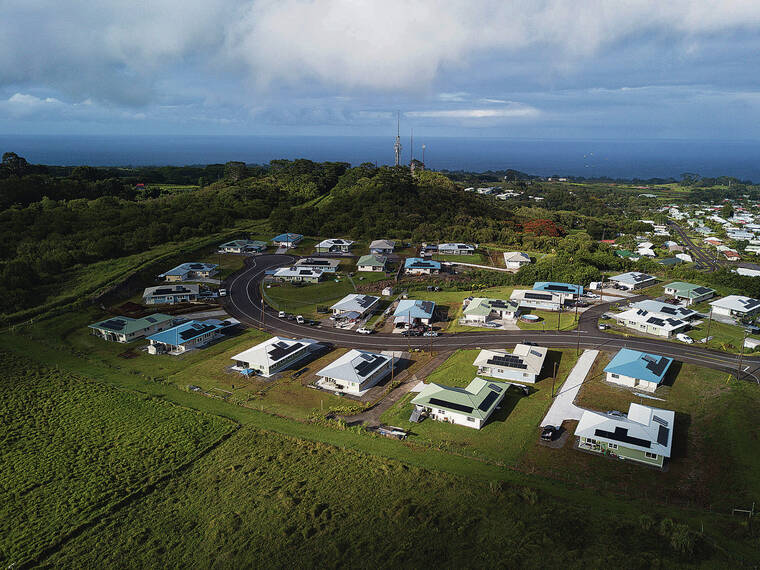Hit hard by high energy costs, Hawaii residents look to the sun

NEW YORK TIMES
Solar panels on Toddi Nakagawa’s home have reduced her electricity bill to $26 a month. Nakagawa is seen in her kitchen at home in Honolulu.

NEW YORK TIMES
Hawaii’s reliance on solar carries lessons for other states and countries looking to switch to renewable energy. Solar panels dot a residential development near Hilo.


Toddi Nakagawa, who lives in a suburb of Honolulu, has spent years battling her family’s high electricity bills, which once topped $500 a month, by gradually buying more solar panels. After accumulating more than 70 panels and three stacks of batteries, she has gotten her family’s monthly bill down to just $26.
Nakagawa is not alone. Nearly one-third of Hawaii’s single-family houses have rooftop solar panels — more than twice the percentage in California — and officials expect many more homes to add panels and batteries in the coming years.
Even before energy prices surged globally this year, homeowners, elected leaders and energy executives in Hawaii had decided that rooftop solar panels were one of the best ways to meet demand for energy and tame the state’s high power costs. Russia’s invasion of Ukraine has only strengthened the state’s embrace of renewable energy. Electricity rates in Hawaii jumped 34% in April from a year earlier because many of its power plants burn oil, about one-third of which came from Russia in 2021.
While Hawaii faces unique challenges, the state’s reliance on solar carries lessons for other states and countries looking to fight climate change and bring down energy costs. The state has increased the use of renewable energy in large part by getting electrical utilities to accept rooftop solar rather than fight it, as energy companies in California, Florida and other states have been doing.
“In Hawaii we’ve come to the recognition that rooftop solar is going to be an important part of our grid, has to be part of our grid,” said Shelee Kimura, president and CEO of Hawaiian Electric Co., the state’s largest power provider. “Some people think we’re crazy. Some people think we’re pretty amazing.”
Less than a decade ago, utilities like Kimura’s pressed state lawmakers to reduce incentives for rooftop solar, a tactic the utility industry has used across the country, arguing that rooftop solar is not as efficient as large solar and wind farms and can force lower-income households to bear more of the cost of the electrical grid. In 2015, Hawaii’s utility regulators reduced how much homeowners were paid for sending the excess energy that their solar panels produced to the grid.
Don't miss out on what's happening!
Stay in touch with breaking news, as it happens, conveniently in your email inbox. It's FREE!
That change slowed the growth of rooftop solar but did little to bring down energy costs. The state’s electricity rates now stand at 39 cents a kilowatt-hour, nearly three times the national average of 14 cents.
Recognizing that reality, state officials in recent years have gone back to encouraging the use of small-scale energy systems. To manage the supply and demand of electricity, for example, Hawaii offers up to $4,250 to homeowners on Oahu, home to about 70% of the state’s population, to install home batteries with their solar systems, defraying as much as one-third of the cost of doing so. Utilities can tap those batteries for power between 6 and 8:30 p.m., when energy demand typically peaks.
“It’s a good example of a good policy pivot with utilities and regulators saying, ‘We need to change how we approach this,’” said Bryan White, a senior analyst at Wood Mackenzie, a research and consulting firm.
A ‘finite resource’
Unlike most of the country, Hawaii burns a lot of oil to generate electricity — a common approach on islands because the fuel is easier and cheaper to ship than natural gas.
“We’re unique in that we’re dependent on oil for more power generation than the rest of the U.S. mainland combined,” Marco Mangelsdorf, a lecturer at the University of California, Santa Cruz, who specializes in the politics of energy and has lived in Hawaii for much of his life.
Power plants fueled by oil supplied nearly two-thirds of Hawaii’s electricity in 2021, down from nearly three- quarters a decade earlier, according to the Energy Information Administration, a federal agency. Rooftop solar, by comparison, supplied about 14%, up from 6% in 2014, the earliest year for which the agency has that data.
The state had imported about 80% of its oil from Russia, Libya and Argentina, which offer a grade that Hawaii’s refinery can process. The remaining 20% came from Alaska.
“Dependence on oil is the wrong path,” said James Griffin, chair of the Hawaii Public Utilities Commission, who has been working to reduce tensions between utilities and the rooftop solar businesses. It hurts the environment, he added, and is expensive.
After Russia invaded Ukraine, the United States banned Russian oil imports, forcing Hawaii to rely on other suppliers. The price of oil surged, which is why the state’s electricity rates have increased so much more than in the rest of the country, where they are up about 9% this year.
This was not the first time Hawaii struggled with energy inflation. In 2008, oil prices jumped above $140, from about $90, in part because of tensions in the Middle East. That forced the state, in collaboration with the federal Department of Energy, to start an initiative to reduce its heavy dependence on fossil fuels. Then, in 2015, Hawaii enacted a law mandating that all its electricity come from renewable sources by 2045.
“We realized that oil is a finite resource,” said Richard Ha, chair of the board of Sustainable Energy Hawaii, a nonprofit organization that was instrumental in pushing the state to embrace renewable energy.
Fight over sources
Even as Hawaii’s leaders sought to do away with fossil fuels, they disagreed about how. Utilities and many lawmakers wanted to invest in large wind and solar farms and further exploit geothermal and hydroelectric energy.
Rooftop solar was considered inadequate. Many energy companies also felt threatened by small-scale energy systems because they reduce the need for larger power plants and transmission lines. The nation’s investor-owned utilities make their money typically by earning a roughly 10.5% return on every dollar they invest in the grid.
But many big renewable- energy projects were delayed, in part because of supply chain problems. And the state is expected to soon close its only major coal power plant. Those problems forced regulators and the utilities to rely more on home power systems.
“These big projects, representing hundreds of megawatts, were being pushed out, pushed out, pushed out,” Mangelsdorf said. “The writing was on the wall.”
Proponents of rooftop solar and home batteries also note that Hawaii does not have lots of cheap, open land needed for large solar and wind farms — a position that Hawaiian Electric, which locals call HECO, came to embrace.
The rooftop solar industry “fought tooth and nail with HECO to get to where we are today,” said Scott Glenn, the state’s chief energy officer. “Not only are their decisions changing, but their attitudes are changing.”
Many residents also decided they could not wait for elected officials and utility executives to bring down energy prices.
Nakagawa, a 54-year-old financial adviser, lives on Oahu, where the electrical grid largely relies on oil-fired power plants. The family’s electricity bill reached its highest level after the family bought its first set of solar panels in 2009.
“We try to conserve,” Nakagawa said. “We open up a window and use a fan.” But she added that sometimes it got so hot and humid that she and her family needed the air conditioner.
They added more solar panels when they built a rental unit. Their home now houses five immediate family members, an uncle and tenants. The Nakagawas spent $74,000 on their energy system, most of which they got back through state and federal tax credits.
Rewards for utilities
A year ago regulators in Hawaii created a performance-based system that rewards utility companies for quickly connecting rooftop solar and battery systems to the grid. Utilities can also earn more money by promoting energy efficiency. That has helped make the adversarial relationship between utilities and ratepayers more cooperative.
“We’ve had to reframe the relationship,” said Kimura of Hawaiian Electric. “You now have so many different players in the energy space. These things have all changed more rapidly than in any time in history.”
In addition to rooftop solar, Hawaii is trying to take advantage of its natural resources.
Hawaii island has vast potential for hydroelectric plants. Volcanic activity makes it possible for utilities in some places to produce geothermal energy.
But some of those resources can also turn dangerous. The remnants of the 2018 eruption of Kilauea Volcano — hardened, blackened lava that raised the ground 60 feet — still surround a geothermal energy plant, which has yet to return to full capacity. Steam continues to rise from fissures in the ground. A few homes that survived the devastation that wiped out neighborhoods depend on rooftop solar panels.
Other islands, like Kauai, use various forms of renewable energy. That island’s utility became a community- owned operation 20 years ago when local business people bought it.
Kauai regularly produces 70% of its electricity from carbon-free sources. It expects to increase that to as much as 90% in 2025, after building a solar farm, batteries and a hydroelectrical facility that operates as a giant battery.
“We’re looking at a real 100% clean energy,” said David Bissell, CEO of the Kauai Island Utility Cooperative. “Absent a tragic hurricane, I think we’ll be there within a decade.”
Like Hawaii, states such as New York and California have set ambitious renewable-energy targets but are still dependent on fossil fuels. The United States as a whole gets about 40% of its electricity from natural gas and about 20% from coal.
“They’re like paving the way for how the electric system can change,” Mary Powell, a former president of Green Mountain Power, a Vermont utility, said about Hawaii.
Powell served on the board of Hawaiian Electric’s parent company before becoming CEO of Sunrun, the largest U.S. residential solar company. She said moving to renewable energy would cost a lot of money but help reduce energy price spikes associated with oil, natural gas and coal.
“What we’re seeing happen with fossil fuels and fossil fuel prices, that’s just going to rip its way through the U.S. economy,” Powell said. “The solution looks obvious to me. It’s painful, but the solution is what Hawaii is doing.”
© 2022 The New York Times Company



